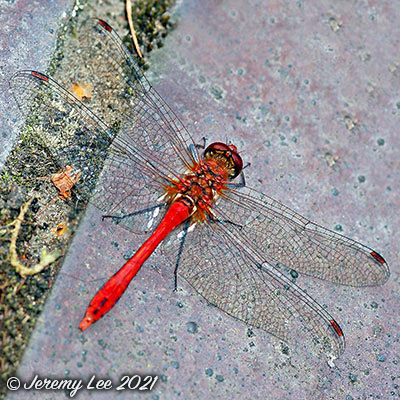
 |
|
Scientific Classifications explained » Amphibians » Ants » Aphids » Bees » Beetles » Birds » Bugs » Butterflies » Caterpillars » Damselflies » Dragonflies » Earwigs » Flies » Frog/Leafhoppers » Fungi » Galls » Grasshoppers » Harvestmen » Hoverflies » Lacewings » Ladybirds » Leaf Mines » Lichens » Mammals » Millipedes » Mosses » Moths » Sawflies » Slugs » Snails » Spiders » Trees & Shrubs » Wasps » Wild Flowers » Woodlice » Postboxes |
UK Nature > Dragonflies > Sympetrum sanguineum

Scientific Name: Sympetrum sanguineum Common Name: Ruddy Darter Sympetrum sanguineum, more commonly known as the Ruddy Darter, specialises in well vegetated ponds, lakes, canals etc., frequently in woodlands. Will tolerate acidic waters. Most common in south-east England and central Ireland but increasing its range. May be confused with other Darter species, the most common other species being the Common Darter. The Ruddy Darter can be distinguished by: 1. Black legs 2. Black line marking extends part way down the side on the frons (face) 3. Male: blood-red coloration and club-shaped abdomen 4. Female: abdomen ochre-yellow with black markings; not club-shaped. Away from the water both sexes usually perch in a tree or bush facing out over open space where they can scan for prey. They will usually return to the same perch after chasing prey or seeing off a rival. |
|

https://www.uknature.co.uk is a website dedicated to showing the immense diversity of UK nature and wildlife. Our vast range of habitats, from lowland arable to snow covered mountains, from storm-ravaged coastlines to peaceful inland freshwater lakes and rivers, from dry, sandy heaths to deciduous and coniferous forests, all these habitats contribute to the abundance of UK nature. We have wild birds in huge numbers either residing or visiting our shores (597 recorded species as at July 2013) and we must also not forget the humble back garden with its grass lawns, flower beds filled with nectar rich flowers, shrubs and trees, all designed to attract huge numbers of insects such as bees, moths, butterflies and hoverflies; and finally the small ponds which provide safe havens for frogs, toads, newts and even slow worms and grass snakes. www.uknature.co.uk is the showcase for my personal passion, photographing uknature in all its glory. I sincerely hope you all enjoy the fruits of my labours. This site and all images contained therein is © Jeremy Lee 2004 - 2025. All Rights Reserved. Site design by Jeremy Lee. Site development & IT Support by Stuart Lee. |